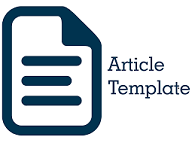The Relationship Between Community Knowledge and The Level of Participation in Natural Tourism Empowerment Activities in Siguntur Tua Kabupaten Pesisir Selatan
Abstract
This research is motivated by the low level of community participation, this is thought to be caused by the community's low knowledge of natural tourism empowerment activities. This research aims to (1) describe community knowledge about empowering natural tourism, (2) describe the level of community participation in empowering natural tourism, and (3) describe the relationship between knowledge and community participation in empowering natural tourism in Siguntur Tua, Pesisir Selatan Regency. This research uses a quantitative approach with a correlational type. The population of this research is 88 people who live in Siguntur Tua, Pesisir Selatan Regency. The sampling technique used cluster random sampling, taking 50% of the population, namely 44 people. The data collection technique uses a questionnaire and data collection tools in the form of a list of statements. Data analysis techniques use percentages and product moments. The results of this research indicate that (1) Community knowledge regarding natural tourism empowerment activities in Siguntur Tua is still relatively low; (2) The level of community participation in natural tourism empowerment activities in Siguntur Tua is still relatively low; and (3) There is a very significant relationship between community knowledge and the level of community participation in natural tourism empowerment activities in Siguntur Tua, Pesisir Selatan Regency. It is recommended to (1) Pokdarwis as the party responsible for increasing public knowledge by conducting outreach; (2) the person responsible for involving the community is more persuasive in communicating so that the community can be involved in empowering natural tourism; (3) the community needs to increase their knowledge by taking part in the socialization held by the Pokdarwis together with the Nagari government.
Keywords: Community knowledge, level of community participation, natural tourism empowerment
Full Text:
PDFReferences
Diatmika, I. P. G., & Rahayu, S. (2022). Model Pemberdayaan Ekonomi Masyarakat Lokal dan
Peran Pemerintah. Malang: Ahlimedia Book.
Mu’alif, W. A., & Ismaniar. (2021). Peluang Pemberdayaan Masyarakat melalui Penyediaan
Program Lifeskill Game Online Pubg Mobile Di Era Teknologi Informasi Serta
Komunikasi Modern. Jambura Journal of Community Empowerment, 2(2), 1–9.
https://doi.org/10.37411/jjce.v2i2.1024
Mukhid, A. (2021). Metodologi Penelitian Pendekatan Kuantitatif. Surabaya: Jakad Media
Publishing.
Mustanir, A., & Abadi, P. (2017). Partisipasi Masyarakat Dalam Musyawarah Rencana
Pembangunan Di Kelurahan Kanyuara Kecamatan Watang Sidenreng Kabupaten
Sidenreng Rappang. Jurnal Politik Profetik, 5(2), 247–261.
Nasrullah, S., & Irawan, B. (2019). Analisis Partisipasi Masyarakat Dalam Pelatihan Sistem
Ketahanan Kebakaran Lingkungan Pada Kantor Penanggulangan Kebakaran Dan
Penyelamatan Sektor Johar Baru Jakarta Pusat. Jurnal Reformasi Administrasi, 6(1), 42–52.
Rukajat, A. (2018). Pendekatan Penelitian Kuantitatif: Quantitative Research Approach. Yogyakarta:
Deepublish.
Supsiloani, S. (2019). Pemberdayaan Masyarakat melalui Pembangunan Bidang Pendidikan
Nonformal. Anthropos: Jurnal Antropologi Sosial Dan Budaya (Journal of Social and Cultural
Anthropology), 5(1), 20–30.
Suriati, S., Ridjal, S., Halim, A., & Mursidah, M. (2014). Manajemen Sumber Daya Manusia.
Pranada Media Group, 6(2), 333–346. https://doi.org/10.37531/yume.vxix.432
Tohani, E. (2020). Hubungan Dialektis Pendidikan dan Pembangunan. Yogyakarta: UNY Press.
Yulita, R., & Irmawita, I. (2022). Community Empowerment Through Plastic Waste
Recycling Skill (Case Study on the Bidarmu Waste Bank). SPEKTRUM: Jurnal
Pendidikan Luar Sekolah (PLS), 10(1), 160.
https://doi.org/10.24036/spektrumpls.v10i1.114892
Zubaedi, Z. (2013). Pengembangan Masyarakat: Wacana & Praktik. Jakarta: Kencana.
DOI: https://doi.org/10.24036/kolokium.v11i3.698
Refbacks
- There are currently no refbacks.

This work is licensed under a Creative Commons Attribution 4.0 International License.

